The titel of my first visit in Vietnam was: Vietnam - Discovery of Charming Nature
1.3.2010 Berlin > Bangkok > Sài Gòn (1) > Mỹ Tho (2) > Vĩnh Long (3) > Sài Gòn > Hà Nội (4)
> Lào Cai > Sa Pa (5) > Hoàng Liên Mountain trekking > Hà Nội > Cát Bà island & town (6)
> Hà Nội > Sài Gòn > Phú Quốc island (7) > Sài Gòn > a week in Bangkok > Berlin
Saigon: Stopover and recover in my favorite Kim Hotel, Bùi Viện
That's the narrow alley of Bùi Viện in the middle of the tourist district. In number 40 you'll find the extremely friendly, family operated Kim Hotel which I have already presented at the very end of 2008-09 Cambodia & Vietnam. 2000 km asiatische Gelassenheit. Teil 2. A room (with all-round view) - like this - on the 4th or 5th floor should be booked well in advance.
Who knows, how long these small family hotels will survive?
With several views from the small "balcony".
By bus to Mỹ Tho
The ride with the normal bus from Ho Chi Minh City to My Tho is nearly two hours (8-10 Euro)
In 2007, I already visited Cần Thơ, the floating markets of Cai Rang and Vinh Long. This year, I wanted to experience life along the river Mekong and the landscape along the river.
Scooters are cheap and gasoline costs almost nothing. You just have to choose one in peace, which works well (attention to the brakes!) and is comfortable. No fear! On the way, everyone will help you, whatever happens.
On the river, many boats pass, which take the tourists to the floating markets. Everywhere on the riverside you will be greeted with wonder and great cordiality, because there is never a foreigner along.
There are still many bridges missing. The ferry crossing costs only pennies.
Below: whole pack of motorcyclists waiting for the ferry.
Vĩnh Tràng Chùa is a Buddhist temple - one of the best-known temples in the Mekong Delta.
As in Thailand, Cambodia and Laos students wear a kind of (school) uniform here as well.
Imagine a ferry across the Elbe near Dresden (Saxony), where an elderly Chinese and four German students drive to the other shore. Do you think that the photos would look like that?
Rang Dong Riverside Hotel in My Tho has 3-star accommodation with a garden, free WiFi, the spacious guest rooms are fitted with a seating area and a
flat-screen TV. Some rooms offer a balcony.
The accommodation offers a continental or buffet breakfast. In 2010 there the breakfast was only rice soup (unusual! ... in German: sehr gewöhnungsbedürftig)
Around Vĩnh Long by motor bike
By bus it is a good one and a half hours from My Tho to Vinh Long. Nearby is the much visited Cai Be river market where I was already in 2007.
The city itself does not have much to offer, but from Vinh Long you can take (boat)trips to the Mekong Delta.
A road along the river is an impassable construction site, so all traffic is ferried past construction sites.
I found a small "restaurant" somewhere in the countryside where I got to know a Vietnamese who had been working in Dortmund for ten years, who built a house here from his savings in Germany. Five men and women sat around us and listened to our unusual language.
Vietnamese people are very open-minded, kind and curious about everything foreign. Away from the tourist centers, they are helpful and sociable, even if they speak only a few words of English. In the South several older Vietnamese can still speak American English. All over the country, many younger people speak (some) English.
Vietnamese people are very open-minded, kind and curious about everything foreign. Away from the tourist centers, they are helpful and sociable, even if they speak only a few words of English. In the South several older Vietnamese can still speak American English. All over the country, many younger people speak (some) English.
A little bit skepticism is appropriate:
2010: There are no beggars in Vietnam, not even in the tourist centers. The offer of meat, fish, vegetables and food is very large, also on household goods and all kinds of products. It seems, the mass of people suffers no shortage. Officially, the unemployment rate 2010 is 4.29%, from 2011 onwards it will fall by half - permanently. The economic development is still growing and positive - also in 2018. But many people still live under extremely primitive conditions. I also suspect (!) that the lack of affordable housing still remains significant.
Temples, stupas and pagodas are also found here like sand by the sea. I can not find out where this one is ... It was a small town that also houses the following museum, which was opened only for me.
Tai (the vietnamese meaning of this first given name is "talent") personally led me to the local museum.
Vinh Long is on the Co Chien River, which branches out from the Mekong
River at the narrows of My Thuan about 10 kilometers upstream, only to
meet it later downstream.
Below are some impressions of Vinh Long: the river bank, a chinese temple, the city, the modern Vingh Long museum (one pic / once again I was the only visitor), the busy market and my hotel.
The only pic from my visit in the museum:
The French invention Guillotine, of course, also used the French colonial masters in Vietnam.
The huge, overflowing markets of South East Asia are always a terrific experience for Europeans - and you just can not stop taking similar pictures over and over again.
Some views from my hotel room.
Vĩnh Long > Ho Chi Minh City > Hanoi
Buses from Vinh Long (some pictures of the bus station) to HCMC (= Saigon) need a minimum of 3 hours (mini buses are faster, but also much more expensive), because the National Road No. 1 is totally overcrowded and on their way there is a stop in a huge restaurant with a huge shop.
Attention! You will end up in Saigon far way out of the center - you can then just take a taxi to go - for example - to the airport (negotiate price !!! In these places taxi drivers are often rather outrageous towards strangers !!!).
I recommend: Do not get into a taxi on the bus station (or railway station), but go out onto the street and stop any taxi.
I recommend: Do not get into a taxi on the bus station (or railway station), but go out onto the street and stop any taxi.
Short Stay Hanoi
The cozy small JASMINE hotel with its enchanting staff and excellent breakfast, only a few steps from the Hoan Kiem Lake, is unfortunately not there anymore. Above - the house altar in the staircase. From my room window I could see over to the lake.
Lào Cia > Sa Pa > and trekking in the Hoàng Liên Mountain
A few important advice for buying a train ticket to Lào Cai (Sapa)
1) Tickets can be bought at the normal price at the counter in the railway station Ga Trần Quý Cáp, 120 Lê Duẩn. Everywhere else are they more expensive, much more expensive or excessive overpriced.
2) The ticket offices are a bit hidden in the left side wing of the railway station, especially in the evening surrounded by a crowd of people.
3) When looking for the ticket counters ask only travelers with suitcases. Others will not tell you the place, but offer to get the (than extremely expensive) tickets for you.
4) Patiently join the queue of those waiting - it is amazingly fast.
5) There are both daytime and overnight sleeper trains between Hanoi & Lao Cai, and on the sleeper trains you can choose between the normal Vietnamese railways sleepers (the cheapest ticket for the night trains is a sleeper chair) or a whole series of privately-run sleeping-cars of a higher standard aimed at tourists (sleeper prices vary depending on the number of beds in the compartment).
6) Not every counter-agent understands or speaks understandable English. Therefore you write your wishes (train number, days, departure time, round trip, place request etc) on a piece of paper (see below). The agents are very friendly and helpful - also other travelers in the queue will help you.
7) Sapa has no railway station, but it's about 38 km (24 miles) from Lao Cai railway station and easily reached from there by bus in about 50 minutes. Enough buses wait in front of the station.
2) The ticket offices are a bit hidden in the left side wing of the railway station, especially in the evening surrounded by a crowd of people.
3) When looking for the ticket counters ask only travelers with suitcases. Others will not tell you the place, but offer to get the (than extremely expensive) tickets for you.
4) Patiently join the queue of those waiting - it is amazingly fast.
5) There are both daytime and overnight sleeper trains between Hanoi & Lao Cai, and on the sleeper trains you can choose between the normal Vietnamese railways sleepers (the cheapest ticket for the night trains is a sleeper chair) or a whole series of privately-run sleeping-cars of a higher standard aimed at tourists (sleeper prices vary depending on the number of beds in the compartment).
6) Not every counter-agent understands or speaks understandable English. Therefore you write your wishes (train number, days, departure time, round trip, place request etc) on a piece of paper (see below). The agents are very friendly and helpful - also other travelers in the queue will help you.
7) Sapa has no railway station, but it's about 38 km (24 miles) from Lao Cai railway station and easily reached from there by bus in about 50 minutes. Enough buses wait in front of the station.
In such a wagon it is quite lively during the first two hours. Many Vietnamese people have no problem with closer body contact to their neighbors (in busses, trains, boats and planes). That was my only problem on this train ride ... When he fall asleep, he fall unabashedly at my shoulder ... but as a stranger I use to remain always polite ...
The city center of Sapa is a single HUGE tourism hype (what I hate) and as much as I understand the Hmong women from the countryside in their costumes, who also want to benefit a bit from tourism, so much does the multitudes of Hmong souvenir traders annoy you.
The Golden Sun Luxus Sapa Hotel, permanently closed now
As soon as you leave the old city center with its tourist hustle and bustle, you will not find a single foreigner in the rest of Sapa.
The Sapa Town Square with the "Love Market" is a permanent souvenir market. In the city of Sapa itself, many of the Hmong women in their costumes ask for money when trying to take photos of them. In the countryside, does this bad habit not exsist.
2 days trekking tour with an overnight stay with farmers in a small village (2010 = 40 US$)

Our young guide waves to me - - - I had two problems of this hike. 1) My five companions were between 24 and 30 years old - I was 66 years old. These five and the guide were walking fast, and they rarely stopped to enjoy the grandiose spans for a few moments. 2) Most of the trails were ok, but the day before it had rained and often the loamy soil was dangerously slippery. It does not matter to young people, but at 66 you get your problems.
That was one of the funniest situations when we arrived at our accommodation. All hikers are accompanied by souvenir sellers on their tour. Here - close to their own homes - is their last chance to sell something. The two boys and the eleven girls haggled for over half an hour with a huge fun before getting any sales.
Here our host still cook the meal.
In the gallery are the sleeping places, separated by sheets.
My own exploration tour north of Sa Pa
Cat Cat, more like a show village for tourists
The Cat Cat village is just a few steps from the Sapa town. It is quite a nice day trip, but I took only some pictures here, the whole thing was too touristic for me. At the bottom of the village you reach the Cat Cat waterfall.
The railway station of Lao Cai.
If you book the trekking tour in your own hotel, then this has the advantage that you do not have to book/pay for the absent days. That's why I had - before/after - two different rooms.

5 very gray days on the island of Cát Bà.
Cát Bà is the largest island in famous Halong Bay. It belongs to a biosphere reserve established by UNESCO and is home to the Cát Bà National Park.
Squeezed together in a minibus, the first part of the route - 120 km - almost two hours drive - took us to Haiphong. There we had to change to another minibus, just as closely squeezed together that took us (see above - 16 km) to Pha Binh Port where we went on board of the ferry that takes about 45 minutes to get to the tourist pier in Cát Bà town. Recommendation: get advice about the tour beforehand and better pay two/three US$ more for some comfort.
The ticket for the ferry is already being bought in Hanoi, it also includes the shuttle bus. Usually it takes three and a half hours. We needed a lot longer, also on the return journey, because the road (16 km) between Haiphong and the jetty was a complete horror construction site.
On arrival you will first see a long chain of colorful high-rise concrete houses with up to 10 floors, behind a „chic“ green shore promenade. That deceives the newcomer ! because it is only the tourists part of Cát Bà town. One hotel sticks to the other (predominantly simple hotels for Vietnamese tourists, backpackers and people like me), restaurants, shops and travel agencies.
About 13.000 people live on the island, 12.000 of them in Cát Bà town. I do not know how many people live on the water (there are many!) and whether they are included in these numbers.
In the harbor overlooking the tourist’s part of the town. In the Cát Bà archipelago, fishing is predominantly near the shore. It is an important coastal fishing ground for North Vietnam. There are still hundreds predominantly traditional fishing boats in use.
My first tour into the interior of the island.
a traditional hearse
Pics from that big part of the city inhabited by vietnamese people and in which i did not meet a single tourist during my whole stay.
my hairdresser salon
Pics of my second tour along the west coast towards the Ben phà Cái Vieng ferry terminal, from where you can reach the mainland, mainly on the road.
My third tour, 23 km across the island (Inter Island Tourism Road, past the entrance to the National Park), to the ferry terminal Gia Luan, where buses are also transferred. A pretty sad gray day because it was drizzling a lot.
I was the only guest at the Yen Thanh Hotel. From my room on the 4th floor I had a great all-round view of the promenade and the harbor - to the right in the direction of the city - to the left towards the southern tip of the island
I still experienced Phú Quốc as a small natural wonder.
In 2017, the following press release appeared: „Once upon a time there was a dream island. Phu Quoc is the most important tropical island in the country. And the Vietnamese have big plans for it. The gem will become a gigantic holiday park: a mix of Las Vegas and Disneyland. The first roller coasters are already running.“
I still met Phú Quốc as a paradise. For the first time in 2007 in loneliness of Ong Lang Beach - now 2010 a second time in a comfortable resort on the tourist Long Beach.
My first tour with the scooter - 24 km heading south - always took me along the coast - you only met fishermen and fishing boats. Only before I reached the main road Nguyen Van Cu did I cross the first settlement. If you look at the Google map today, huge changes have taken place in the past eight years in this pure natural landscape (in An Thới, on the southern tip) - including a huge shopping mall - - -
The bustling little town of An Thới with its harbor, its naval base and soldiers of the Vietnamese Navy is divided into Khu1, Khu2 and Khu3. The main attraction for me is always the market with the locals and dealers, exotic smells, poultry and food stalls.
It is around 11 km by scooter from An Thới harbour to Bãi Sao, the so-called 'beach of the stars'. Onto the main road Nguyen Van Cu at no 350 you are passing by the Phu Quoc Prison (Di tích Nhà tù Phú Quốc) ...
... It was built in 1967-68 by U. S. Army Engineers for detention of captured Viet Cong and North Vietnamese soldiers. Many of the high ranking leaders of Vietnam were detained here. It is ranked a special historical relic of national significance by the government of Vietnam. The most famous site in this prison are the "tiger cages". A Red Cross team visited the prison in 1969 and 1972. They found that there had been savage and systematic torture of prisoners of war for a long time.They also found traces of corporal punishments used against prisoners of war such as electrical shocks and food deprivation. In August 1971, an inspector from the embassy of the United States in the Republic of Vietnam reported on the continuous tortures at Phu Quoc Prison.
Lesenswert: Zwischen Stacheldraht und Fischsoße in DIE ZEIT
2010 the largely deserted km-long white sand beach Bãi Sao was still truly heavenly. Except for some small simple restaurants, there was only the My Lan Hotel, almost only Vietnamese guests (?), noisy, crowded, lots of kids and exhibited aggressive animals imprisoned in tight cages. But the rest was a dream. I would doubt if this beach is still the same today (?)
2010 the largely deserted km-long white sand beach Bãi Sao was still truly heavenly. Except for some small simple restaurants, there was only the My Lan Hotel, almost only Vietnamese guests (?), noisy, crowded, lots of kids and exhibited aggressive animals imprisoned in tight cages. But the rest was a dream. I would doubt if this beach is still the same today (?)
alotrip writes about Dương Đông Town „ ... is the convergence of the most wonderful beauty of Phu Quoc tourism. Here, tourists will feel the fresh atmosphere of the island dyed blue ... Dương Đông Town is also the central rendezvous of tourists to Phú Quốc. Thanks to extremely convenient geographical location, dreaming romantic natural scenery, Dương Đông Town is increasingly attracting tourists to Phú Quốc travel.“
This is cheap promotion nonsense !!!
Dương Đông Town is the administrative center of the island, home to more than half of the population concentrating around the airport area and divided into 2 parts by Duong Dong River. Today (2018) Dương Đông Town has a population of about 50,000 people. Apart from the bulging colorful and bustling fishing port, the town itself is terribly boring. Today (2018), the very tourist night market does not have a good image any more (see 'tripadvisor').
I am already starting with the booked Sea Star Resort (Sao Biển Resort). In the high season of 2010 the comfortable sea view bungalow cost US $ 45. The breakfast was mediocre, the restaurant with a great view „not really cheap“.
But that is past. In the meantime the resort has been extensively renovated, modernized and even built a pool (so you do not have to go into the sea 😄). This more luxury means much higher prices.
In the evening, a few non-stationary simple restaurants opened right on the beach - the menu with normal low prices. They built tables and chairs around their food stall. I was always one of the first guests, when the kitchen was still set up, because later (spectacular sunsets) it was full and you had to wait a long time for the food.
On the left, heading south, in 2010 you still could walk from the resort endlessly on the shore or on the beach through a diverse natural landscape - what the following 24 shots show.
Say goodbye to Phú Quốc:
In 2010, there were only internal Vietnamese flights possible from Ho Chi Minh City to and from Phu Coq. In 2012, the end of the paradise began. The construction of Phu Quoc International Airport was put into operation on 2 December 2012. Replaced old Phu Quoc Airport. The maximum capacity of the new airport will be 7 million passengers per annum, with international destinations - direct flights - from Singapore, London, Italy ... It is capable of handling aircraft like the Airbus A350 and Boeing 747. Goodbye beautiful island paradise.
Bangkok’s local name is Krung Thep = City of Angels
Suan Pakkad Palace Museum, a pearl in Bangkok’s big city jungle
Its name means 'cabbage patch', in reference to when the land was nothing more than just that. Today, however, it's a green and blooming dream of a garden tropical garden - in the middle of a sea of houses - with serene ponds surrounding traditional Thai houses, each of which brims to overflowing with fine arts, antiques and oddities belonging to Prince and Princess Chumbhot.
I was there at 9am in the morning with only one other visitor - so we experienced a magical tour. I do not like these tourist crowds.
In a spirit of sharing, they converted their traditional private residence to a museum back in 1952, the first instance of a Thai family doing so. Their philanthropic rationale was that while treasured possessions are private property, they still constitute a part of mankind's heritage and as such should be made accessible to all.
The Dusit Palace
In contrast to the dreamy Suan Pakkad Palace, the Dusit Palace is a so-called tourist „highlight“ in which it is teeming with visitors. As you already know from all my travelogues: I do not like these „highlights“ with their tourist crowds.
Dusit Palace is a compound of royal residences in Bangkok. Constructed over a large area north (you have to walk a lot!) of Rattanakosin Island between 1897 and 1901 by King Chulalongkorn (Rama V). The palace, originally called Wang Suan Dusit or Dusit Garden Palace, eventually became the primary (but not official) place of residence of the King of Thailand. The palace covers an area of over 64.749 square metres and is dotted between gardens and lawns with 13 different royal residences.
King Chulalongkorn got the idea of having a royal residence with spacious gardens on the outskirts of the capital from European monarchs during his trip to Europe in 1897. When he returned to Bangkok he began to build a new royal compound within walking distance of the Grand Palace. He began by acquiring several connect farmlands and orchards and he decided to name this area Suan Dusit meaning 'Celestial Garden'. The first building within this area was just a single story wooden structure for occasional stays. In 1890 plans for a permanent set of residences are drawn up and constructions were begun. The king also ordered the construction of Wat Benchamabophit nearby to serve as the palace's official temple.
In a local Chao Phraya river boat.
From this picture I lose the orientation. I do not remember when I was where.
This day was a disaster. As a trip is recommended: „drive off this green jungle of Amphoe Phra Pradaeng (about 40 minutes from Khao San Road by bus number 47) on stilts and make sure coffee break in the Tree House.“ I waited for the bus for three quarters of an hour (instead of just getting into a taxi). Then I drove well over an hour (!) until the bus driver waved me out on a major shopping street and I had no idea where I was (at the end of the world) and how to proceed.
From 1999 to 2010, hotel prices in Bangkok have exploded. The cheapest one I could find was the relatively simple Swan Hotel near the Mandarin Oriental Hotel. The small Standard Single Room for 1 person with private balcony facing to the pool (and outdoor swimming pool, but apparently without breakfast) still costs 27.27 US$ (2018) only. The breakfast was pretty ordinary.
Once again a few views of the fantastic architecture of the new Bangkok Suvarnabhumi Airport (opened in 2006).




















































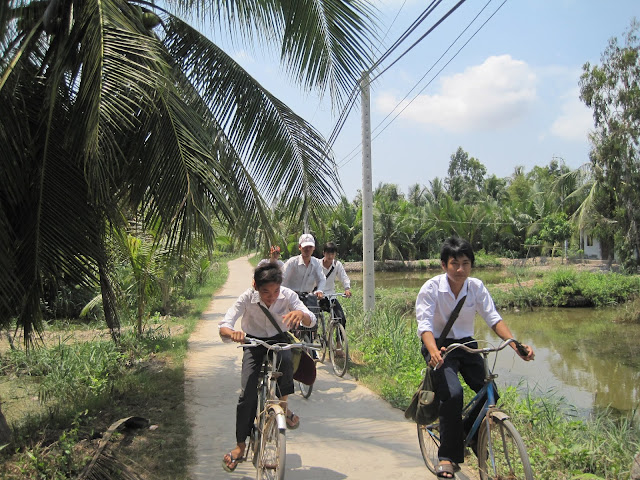











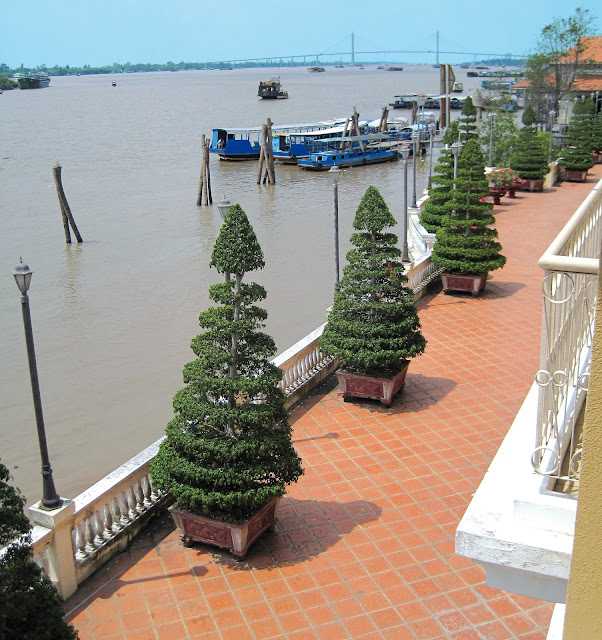












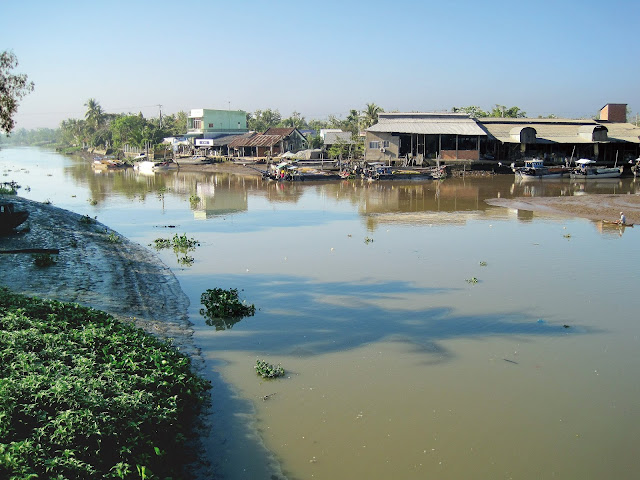




















































































































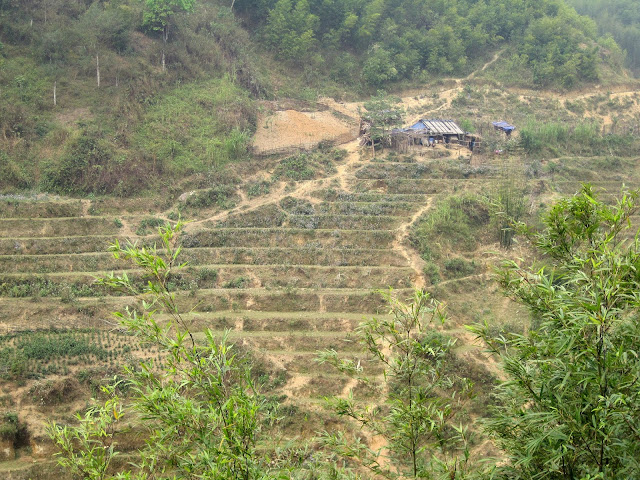




































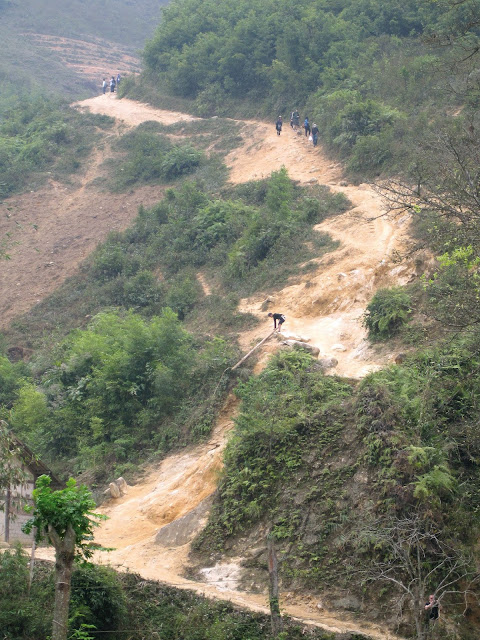


























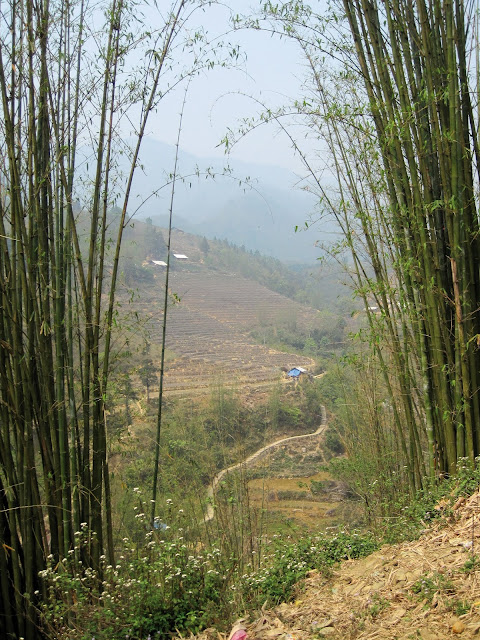


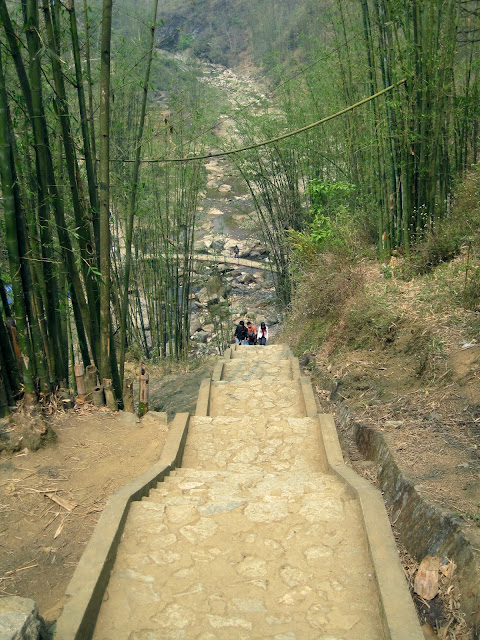








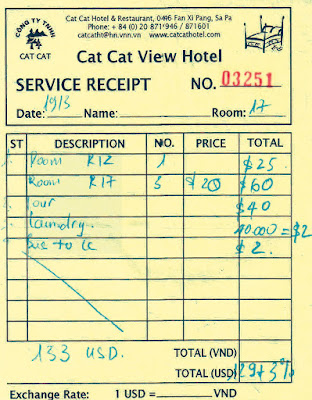





































































































































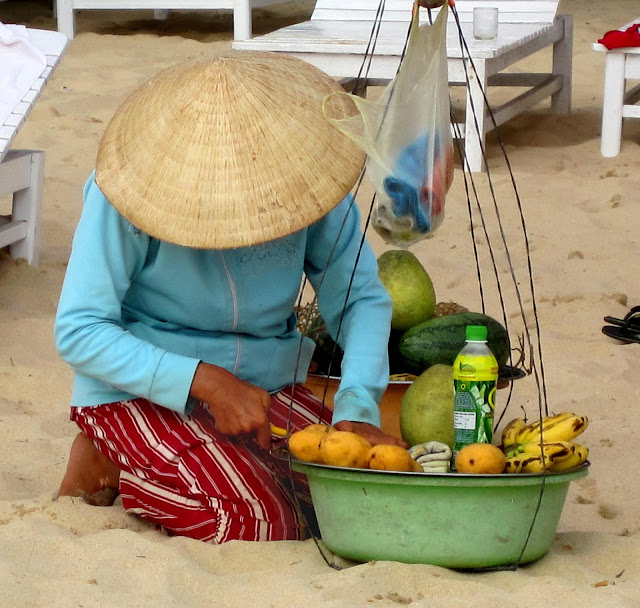
















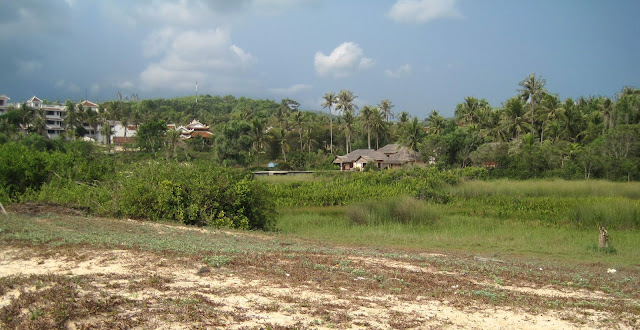
















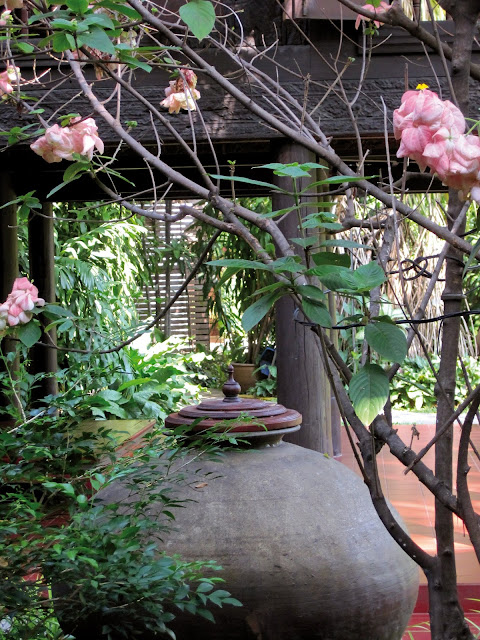

















































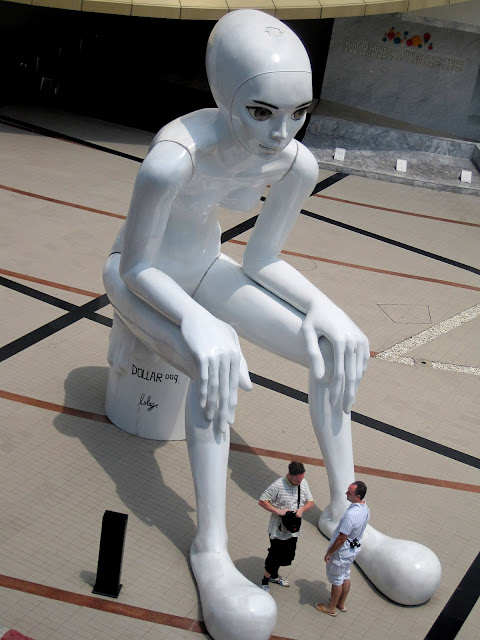










Keine Kommentare:
Kommentar veröffentlichen